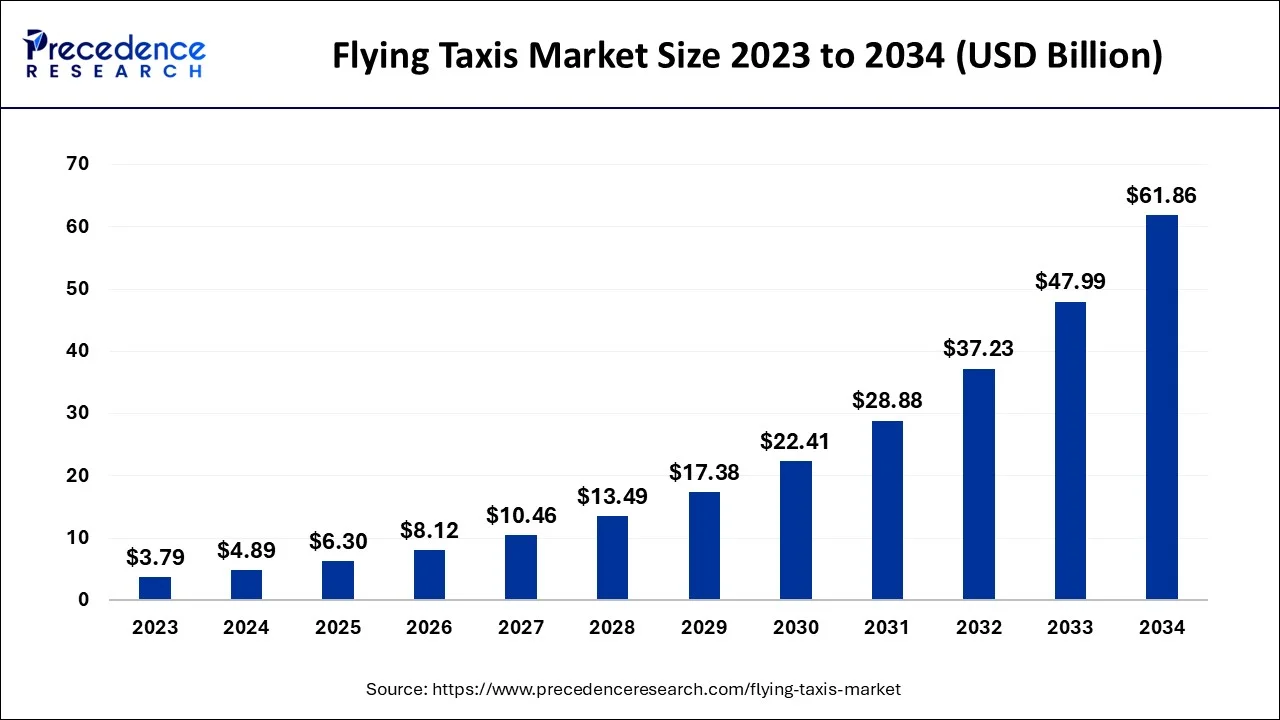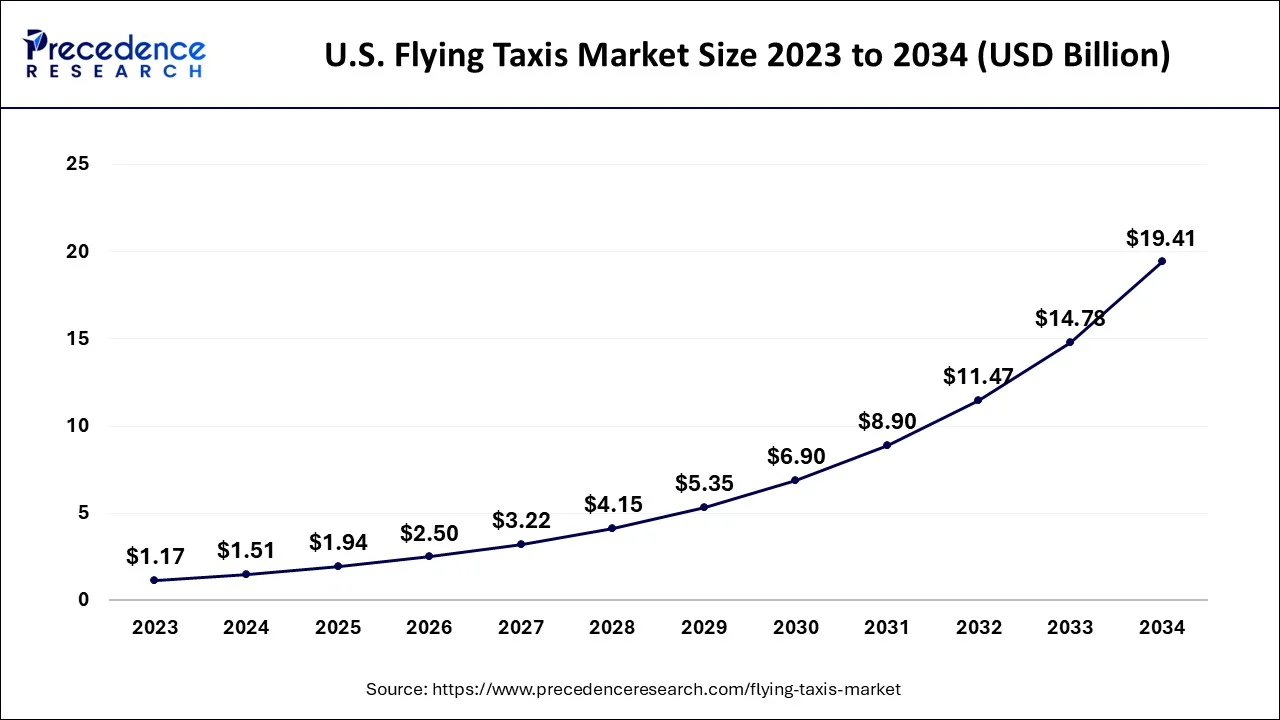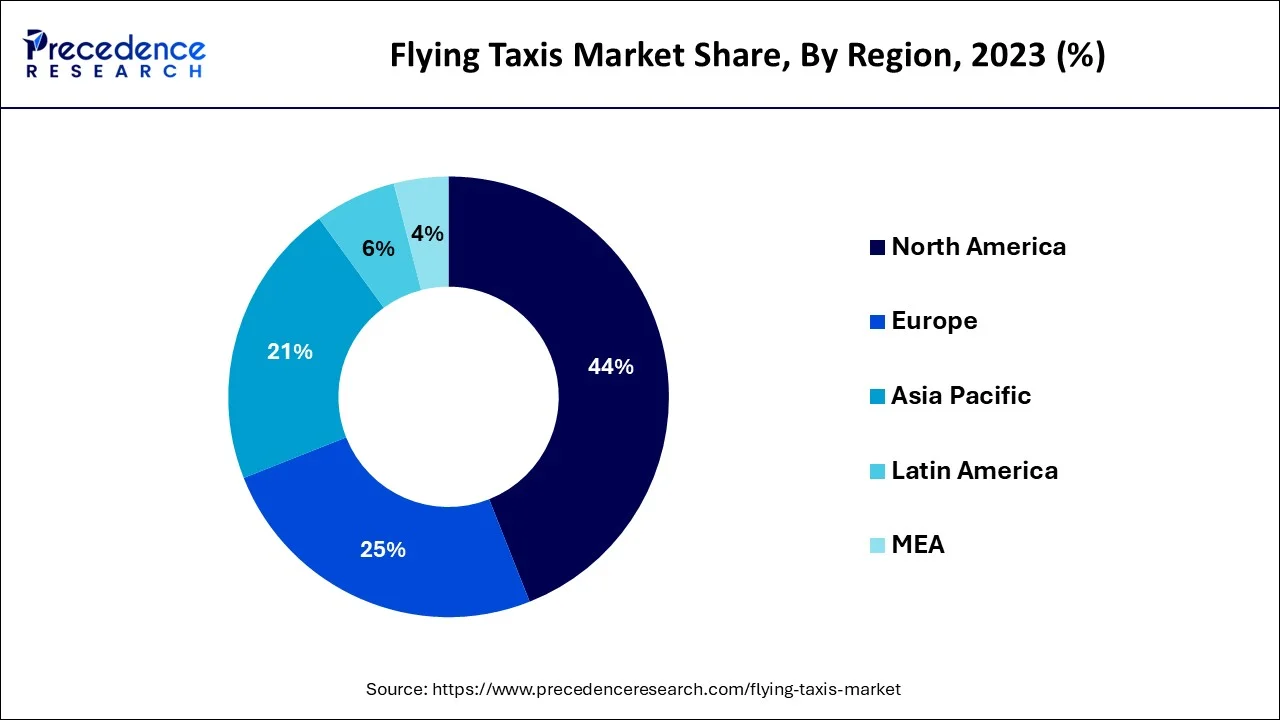List of Contents
Flying Taxis Market Size and Forecast 2024 to 2034
The global flying taxis market size accounted for USD 4.89 billion in 2024 and is anticipated to reach around USD 61.86 billion by 2034, expanding at a CAGR of 28.90% between 2024 and 2034.

Flying Taxis Market Key Takeaways:
- North America is predicted to the maximum market share from 2024 to 2034.
- By Propulsion Type, the parallel hybrid segment captured a significant share of the global market in 2023.
- By Propulsion Type, the electric segment is expected to expand at the fastest CAGR from 2024 to 2034.
- By Aircraft Type, the multicopter segment is predicted to grow significantly with the largest market share between 2024 and 2034.
U.S. Flying Taxis Market Size and Growth 2024 to 2034
The global flying taxis market size is estimated at USD 1.51 billion in 2024 and is expected to be worth around USD 19.41 billion by 2034, growing at a CAGR of 29.04% from 2024 to 2034.

North America held the dominating share of the market,the region is expected to dominate the market with the largest market share revenue during the forecast period. The region continues its dominance with its early adaptability in technology. A faster lifestyle and an increasing need for a faster transportation system will increase the demand for flying taxis. Increasing investment in research and development programs by the government of the nations like the United States and Canada will also highlight the development of the market. Moreover, significantly rising technological innovations are likely to propel the growth of the flying taxis market. In addition, the governments in the region support the utilization of flying taxis along with other modern transportation modes, this element acts as the driving factor for the market's growth in the region.
For Instance, US Federal Aviation Association (FAA) recently passed new rules that can open the door for commercial air taxi operations from the mid of the decade. FAA issued the proposal to update its carrier definition and add “Powdered lift” operation rules to cover other commercial operations like charters, airlines, and air tours.

Asia-Pacific is expected to hold significant market revenue during the analyzed period.The growth of the market is attributed to the increasing population in the region. The increasing population results in higher traffic conditions and this factor mainly contributes to the demand for modern and convenient transportation modes, such requirements are observed to highlight the demand for flying taxis in the region. Increasing technological innovation in the automobile and aircraft industry will likely boost the demand for flying taxis in the forecast period.
Multiple key players in the market Asia Pacific are investing in the research and development of modern transportation modes such as air taxis along with substantial government support. For Instance, EHang, the China-based flying taxi company is carrying out multiple test flights with live employees and passengers, with promising results.
Flying Taxis Market Overview
In the new era of transportation, there are several modes of transportation for the population. The increasing global population is the biggest reason for the increase in the transportation sector. The increasing population will result in traffic conjunction in many nations. Flying taxis are the latest technological innovation in the automotive industry to overcome these problems. Flying taxis is the kind of mini aircraft that can be useful for the daily transportation of people from their working places to home or any other places that they want to go.
Flying taxis will be the fastest mode of transportation with lower traffic conjunctions and it gives a hassle-free experience to the consumers. Consumers just need to go to the vertiports with their scooters or other mobility vehicle and get their air taxis as other normal taxis and the aircraft will take them rapidly across the city to other cities or anywhere else within a 100-150 miles radius.
Flying taxis are the latest technological innovation in the automobile industry. Air taxis are also known as mini-intercity aircraft which can be made for shorter and faster transportation for the consumers. Flying taxis are commercial mini-aircraft solutions for commuters from one place to another.
Flying Taxis Market Growth Factors
From several surveys, it is clear that the people would people are ready for the transformation in the transportation sector. Increasing consumer awareness about the technologies would likely grow the demand for the flying taxis market. Flying taxis can be made of various propulsion-type hybrid, electric, turboelectric, and turboshaft. The flying taxis can be electric or conventional fuel based. Increasing investment by the manufacturer in the flying taxis market would contribute to the growth of the market.
Market Scope
| Report Coverage | Details |
| Market Size in 2024 | USD 4.89 Billion |
| Market Size by 2034 | USD 61.86 Billion |
| Growth Rate from 2024 to 2034 | CAGR of 28.9% |
| Largest Market | North America |
| Base Year | 2023 |
| Forecast Period | 2024 to 2034 |
| Segments Covered | By Propulsion Type and By Aircraft Type |
| Regions Covered | North America, Europe, Asia-Pacific, Latin America, and Middle East & Africa |
Market Dynamics
Driver
Zero carbon emission offered by electric flying taxis
The increasing global concern about climate change and the need to reduce carbon emissions has led to a growing demand for sustainable transportation solutions. Electric flying taxis, with their zero carbon emissions during operation, are seen as an environmentally friendly alternative to traditional fossil fuel-powered vehicles. This aspect appeals to individuals and communities looking for greener transportation options, which in turn drives market growth.
The development of electric propulsion technology for aviation is advancing rapidly. As battery technology improves, flight ranges increase, and charging infrastructure becomes more widespread, the viability and practicality of electric flying taxis improve. Technological advancements drive market growth by enhancing the performance, efficiency, and reliability of electric aircraft, making them more appealing to operators and customers alike.
Restraint
Limitations on carrying passengers
There are many benefits to the use of flying taxis in the upcoming years. But with the advantages, there are some disadvantages also there such as the size and the capacity of the flying taxis. It is not capable of carrying many passengers at one time due to its smaller size and capacity. The design of flying taxis is made for a limited number of people because it is lightweight and gets off the ground easily. Normally, a basic design of flying or air taxis is capable of carrying five to six passengers. The limitations of carrying passengers in flying taxis are observed to hamper the growth of the market by limiting its adoption by end-users.
Opportunity
Government initiative for the sustainability of transportation
Governments can provide funding and investment opportunities to support the development and deployment of flying taxis. This can include research grants, subsidies, and tax incentives to encourage companies to invest in the technology and infrastructure required for flying taxi operations. Government support can help accelerate the growth of the market by providing financial resources for research, development, and commercialization. Flying taxis require a supportive infrastructure to operate effectively. This includes the development of landing pads, charging stations, and air traffic management systems tailored for urban air mobility. Governments can invest in the construction and maintenance of this infrastructure, creating opportunities for collaboration between market players. Such elements associated with the government's support are expected to offer significant opportunities for the market's growth.
Propulsion Type Insights
The parallel hybrid segment held a significant share of the market in 2023, the segment will continue to grow at a noticeable rate during the forecast period. Flying taxis powered by parallel hybrid systems combine the benefits of both electric and traditional combustion engines. The combustion engine provides extended range capabilities, allowing the flying taxis to cover longer distances without the need for frequent recharging or refueling.
Parallel hybrid systems help address regulatory concerns regarding battery limitations, weight restrictions, and safety requirements. They offer a balance between the benefits of electric propulsion and the familiarity and proven track record of combustion engines, which can facilitate regulatory approvals and certifications for flying taxis.
On the other hand, the electric segment is expected to grow at the fastest rate during the forecast period, electric propulsion systems are considered a promising solution for the flying taxi market, offering environmental benefits, operational efficiency, and the potential for growth and innovation in the coming years. Electric propulsion systems produce zero direct emissions during operation, reducing air pollution and greenhouse gas emissions. With growing concerns about climate change and the need for sustainable transportation, electric propulsion aligns well with the goals of reducing carbon footprint.
Aircraft Type Insights
The Multicopter segment is expected to grow significantly with the highest market share in the predicted time period. The growth is attributed due to its smaller and more convenient size for air taxis. Since Multicopter aircraft are aerodynamically unstable, steady flying is entirely dependent upon an onboard computer. The advancement of autonomous technologies has played a significant role in the growth of multi copters in the flying taxi market. Many companies are investing in developing autonomous flying systems that can safely and efficiently transport passengers without the need for a human pilot. This automation allows for more scalable and cost-effective operations, making flying taxis a viable transportation option.
The quadcopters will rise significantly with a steady market share in the forecast period. Quadcopters offer excellent maneuverability and agility compared to traditional aircraft. They can hover, perform tight turns, and navigate through narrow spaces with ease. This level of control is crucial for flying taxis operating in urban areas, where they need to navigate around buildings, traffic, and other obstacles.
Flying Taxis Market Companies
- Joby Aviation
- EHANG
- TERRAFUGIA
- Opener
- Volocopter GmbH
- Kitty Hawk's
- Airbus
- Aero Mobil's
- Uber's VTOL
- Beechcraft Corporation
- Embraer
- Dassault Aviation SA
- Gulfstream
- Cessna
- Boeing
Recent Development
- In May 2023,the ePlane Company, a prominent air mobility startup announced that the company has received a design organization approval from the Directorate General of Civil Aviation (DGCA). The approved design makes the company India's first electric aircraft company to receive this nod.
- In May 2023,Volocopter announced that it has entered in a collaboration with Swiss Aviation Software (Swiss-AS) in order to sign a specific multi-year contract for the utilization of repairs and maintenance.
Segments Covered in the Report:
By Propulsion Type
- Parallel Hybrid
- Electric
- Turboshaft
- Turboelectric
By Aircraft Type
- Multicopter
- Quadcopter
- Others
By Geography
- North America
- Europe
- Asia-Pacific
- Latin America
- Middle East and Africa
For inquiries regarding discounts, bulk purchases, or customization requests, please contact us at sales@precedenceresearch.com
Frequently Asked Questions
Ask For Sample
No cookie-cutter, only authentic analysis – take the 1st step to become a Precedence Research client